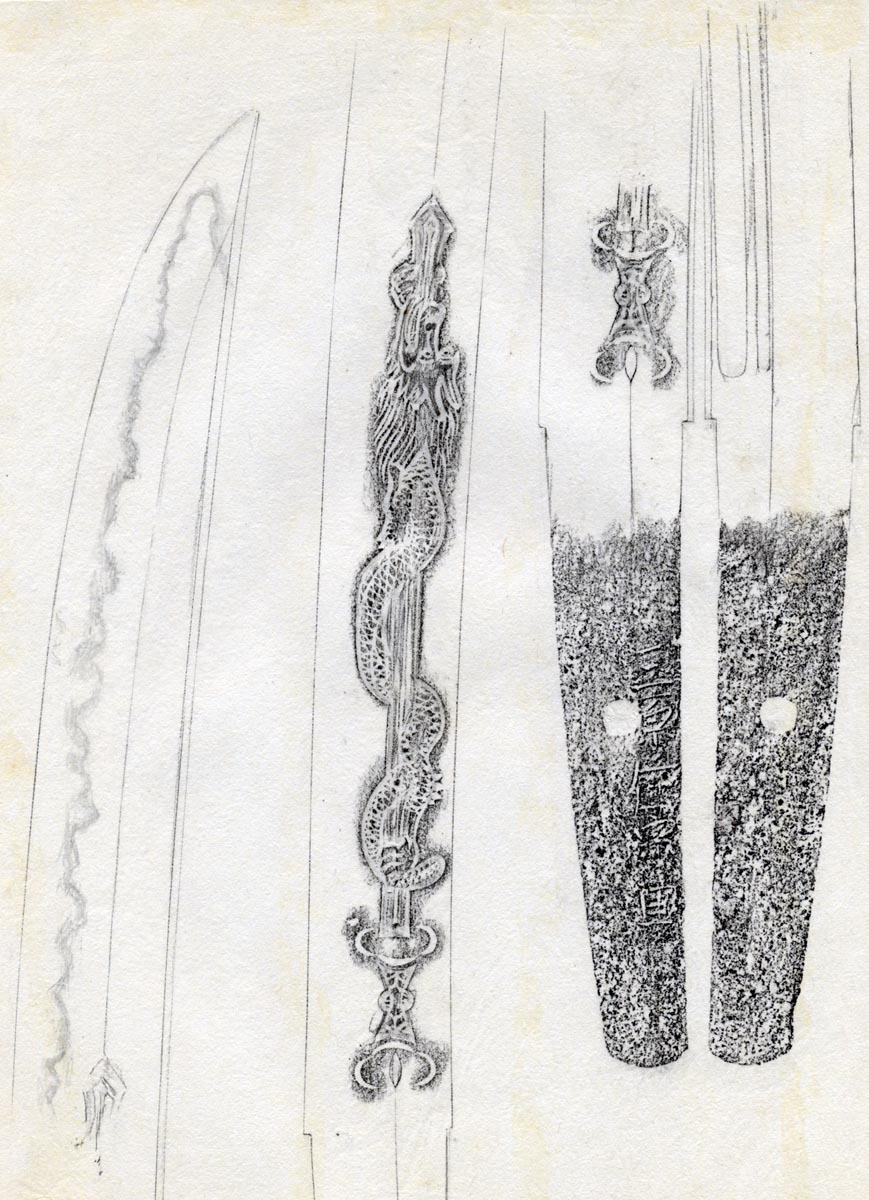| © Copyright Robert Cole 2015
- No copying or distributing The Eight DO SANYODO - The Eight Roads of KOTO |
|
TOMO MIHARA
KO-MIHARA MASAIYE TOKU-JI 1306
KO-MIHARA MASAIYE TEI-WA 1345
KO-MIHARA MASANOBU MEI-TOKU 1390
________|_____ _________
O-AN SADATSUGU - Moved to TOMO in O-EI 1394 TOMOTSUGU
|_______________________________________ O-EI 1394
________|___ - brothers - ________|____
TOMO SADAIYE O-EI 1394 TOMO IYETSUGU O-EI 1394
|________________________ ___|____
___|_____ -brothers- ___|____ IYETSUGU CHO-ROKU
SADATSUGU KYO-TOKU 1452 SADAHIRO ___|____ 1457
| TOMO Founder KO-SHO 1455 IYETSUGU MEI-O 1492
| ________ ________ ___|____
| SADAHARU SADANAGA CHO-ROKU 1457 IYETSUGU EI-SHO 1504
|_______________________ ____________
___|_____ ___|____ ___|____
SADATSUGU BUN-MEI 1469 SADAHIRO MUNESADA KAN-SHO 1460
___|_____ O-NIN 1467 ___|____
SADATSUGU ________ MUNESADA CHO-KYO 1487
TEN-MON 1532 SADAHIRO ___|____
_________ EI-SHO 1504 MUNESADA EI-SHO 1504
NOBUTSUGU KO-SHO 1455 ___|____
______________ MUNESADA TEN-SHO 1573
MIHARA SADAIYE BUN-MEI 1469 _________ _________ ____________
_________ TSUGUTOMO MUNESHIGE ODA IYESHIGE
MOTOTSUGU CHO-KYO 1487 - TAI-EI 1521 - TEN-MON 1532
IYETSUGU O-EI (br: SADAIYE): Came to TOMO on his own initiative.
IYETSUGU is considered a separate TOMO line because TOMO-
style is KYO-TOKU period - from his brothers' son.
Slightly curved WAKIZASHI length swords are plentiful.
ITAME on the HA hammered from MASAME. SUGUHA, CHU-SUGU
KO-MIDARE and GUNOME HA. Following generations in
CHO-ROKU 1457, MEI-O 1492 and EI-SHO 1504.
BISHU TOMO JU IYETSUGU
SADAIYE O-EI (br: IYETSUGU): ITAME. SUGUHA and GUNOME.
SADAHIRO KO-SHO (f: SADAIYE): MOKUME with MASAME. GUNOME HA.
SADATSUGU KYO-TOKU (f: O-EI SADAIYE from O-AN SADATSUGU):
TOMO Founder. A competing theory has BITCHU AOE
SADATSUGU transferring to BINGO in O-EI. TOMO style
commences in KYO-TOKU 1452. Long TANTO. WAKIZASHI length
of slight curve. Swords show raised SHINOGI. ITAME with
JI-NIE. KO-NIE SUGUHA with slight NOTARE where slight
HOTSURE may brush from the line. KO-GUNOME MIDARE is seen
within a generally even line. BO-UTSURI. UBU NAKAGO has a
gentle swell and either straight falling or with slight
curve to a rounded slightly low-reaching HA-AGARI.
TOMO SADATSUGU found in BUN-MEI and TEN-MON.
SADATSUGU
BISHU TOMO JU SADATSUGU
TOMO MIHARA
MUNESADA KAN-SHO (f: SADATSUGU): MOKUME with MASAME. SUGUHA and
GUNOME. Follows: CHO-KYO, EI-SHO and TEN-SHO.
TOMOTSUGU O-EI: SUGUHA and SUGU KO-MIDARE BA.
SADAIYE BUN-MEI (t: MASAZANE): MIHARA style SUGU KO-MIDARE. ASHI.
IYESHIGE TEN-MON: MOKUME with MASAME. SUGU KO-MIDARE or GUNOME HA.
|
Mihara
Muneshige Mihara Muneshige Nagasa:14 7/8" (37.6cm) Moto-haba: 1 3/16" (3cm) Nakago: 5 1/8" (12.9cm) Nagamaki style Ko-Wakizashi with very strong Kurikara Dragon and Vajra Ken Horimono. Very strong Mokume has O-Hada and Ji-Nie. Masa along the Ha. Ko-Nie and Nioi Gunome-Midare with deep Nioi Ashi. Kinsuji and Sunagashi define figures. Jizo Boshi. Ubu Nakago, one Mekugi-ana. Mihara Ju Muneshige |
|